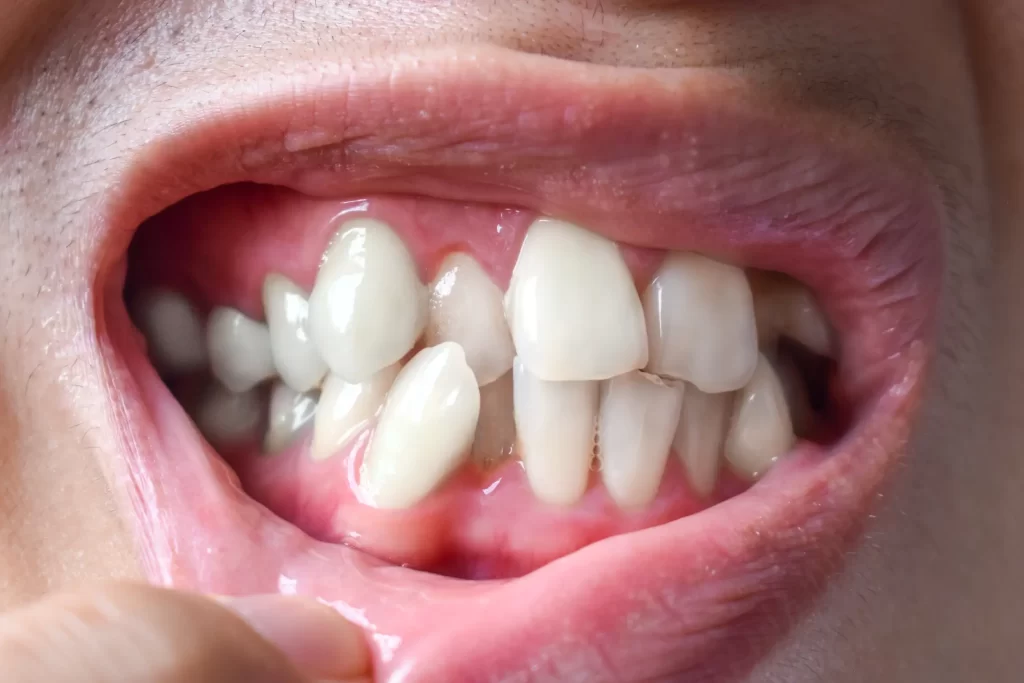Book
Appointments
in Advance
Let our specialist talk to you
Home » Misaligned Teeth
Misaligned Teeth
Overview
Misaligned teeth, also known as malocclusion, refer to teeth that are not properly aligned or don’t fit together correctly when the jaws are closed. This can be due to a variety of factors, including genetics, childhood habits, and certain medical conditions.
Malocclusion can cause a range of dental problems, including difficulties with eating and speaking, abnormal wear and tear on teeth, and an increased risk of tooth decay and gum disease. In some cases, misaligned teeth can also cause cosmetic concerns, such as an uneven or unattractive smile.
Causes
Misaligned teeth can have a variety of causes, including:
- Genetics: In many cases, misaligned teeth are inherited and run in families.
- Habits: Certain habits, such as thumb-sucking, tongue-thrusting, and using a pacifier beyond infancy, can contribute to misaligned teeth.
- Dental problems: Dental issues, such as missing or extra teeth, can cause the remaining teeth to shift and become misaligned.
- Jaw problems: Abnormalities in the jaw or facial bones can cause misaligned teeth.
Symptoms
The symptoms of misaligned teeth can vary depending on the severity of the malocclusion. Common symptoms include:
- Crowded or overlapping teeth
- Gaps between teeth
- Difficulty biting or chewing
- Speech difficulties
- Jaw pain or discomfort
Problems
Untreated misaligned teeth can lead to a variety of dental and orthodontic problems, including:
- Tooth decay and gum disease: Misaligned teeth can be more difficult to clean properly, increasing the risk of tooth decay and gum disease.
- Jaw pain and headaches: Malocclusion can cause stress on the jaw and lead to pain and headaches.
- Speech difficulties: Misaligned teeth can affect speech and pronunciation.

Diagnosis
A dentist or orthodontist can diagnose misaligned teeth through a visual examination, x-rays, and other diagnostic tools.
Treatment
The treatment for misaligned teeth depends on the severity of the malocclusion. Some treatment options include:
- Braces: Traditional metal or ceramic braces can be used to gradually shift teeth into the correct position.
- Clear aligners: Clear aligners, such as Invisalign, are a more discreet option for straightening teeth.
- Orthodontic headgear: Headgear can be used to correct more severe malocclusions.
- Tooth extraction: In some cases, teeth may need to be extracted to create more space and allow the remaining teeth to shift into the correct position.
Prevention
Preventing misaligned teeth can be difficult, as many cases are inherited or caused by factors beyond a person’s control. However, there are some preventive measures that can be taken, such as avoiding prolonged pacifier use, thumb-sucking, and other habits that can contribute to malocclusion. In addition, maintaining good oral hygiene habits, such as brushing twice a day, flossing daily, and visiting a dentist regularly for check-ups and cleanings, can help prevent dental problems that can lead to misaligned teeth.
Start Your Treatment Now
Our specialist for
Misaligned tooth

Dr. Katta Balajee Krishnamurthy
BDS, MDS - Orthodontics & Dento- Facial Orthopaedics
25+ Years of Experience
Speciality:
Adult Orthodontics (Lingual Orthodontics), Ceramic Braces, Invisalign (Invisible Aligners), Micro-Screw Implants, Self-Ligating Braces & Digital Dentistry

Dr. Parzhan Zubin Nalladaru
BDS, MDS - Orthodontics & Dento-Facial Orthopaedics
5+ Years of Experience
Speciality:
Children & Adult Orthodontics, Cleft Cases, Ortho-Surgical Treatments, Invisalign Braces (Invisible Aligners)

Dr. Tarika Gopal
BDS, MDS - Orthodontics & Dento-Facial Orthopaedics
4+ Years of Experience
Speciality:
Adult and Children Orthodontics, Myofunctional therapy, Self-ligation system, Orthognathic surgeries and cleft cases

